生物英语翻译
- 格式:ppt
- 大小:235.00 KB
- 文档页数:67
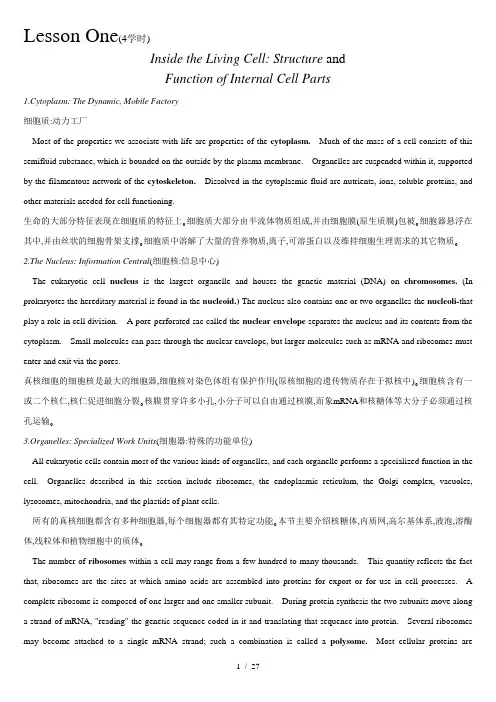
Lesson One(4学时)Inside the Living Cell: Structure andFunction of Internal Cell Parts1.Cytoplasm: The Dynamic, Mobile Factory细胞质:动力工厂Most of the properties we associate with life are properties of the cytoplasm. Much of the mass of a cell consists of this semifluid substance, which is bounded on the outside by the plasma membrane. Organelles are suspended within it, supported by the filamentous network of the cytoskeleton. Dissolved in the cytoplasmic fluid are nutrients, ions, soluble proteins, and other materials needed for cell functioning.生命的大部分特征表现在细胞质的特征上。细胞质大部分由半流体物质组成,并由细胞膜(原生质膜)包被。细胞器悬浮在其中,并由丝状的细胞骨架支撑。细胞质中溶解了大量的营养物质,离子,可溶蛋白以及维持细胞生理需求的其它物质。2.The Nucleus: Information Central(细胞核:信息中心)The eukaryotic cell nucleus is the largest organelle and houses the genetic material (DNA) on chromosomes. (In prokaryotes the hereditary material is found in the nucleoid.) The nucleus also contains one or two organelles-the nucleoli-that play a role in cell division. A pore-perforated sac called the nuclear envelope separates the nucleus and its contents from the cytoplasm. Small molecules can pass through the nuclear envelope, but larger molecules such as mRNA and ribosomes must enter and exit via the pores.真核细胞的细胞核是最大的细胞器,细胞核对染色体组有保护作用(原核细胞的遗传物质存在于拟核中)。细胞核含有一或二个核仁,核仁促进细胞分裂。核膜贯穿许多小孔,小分子可以自由通过核膜,而象mRNA和核糖体等大分子必须通过核孔运输。anelles: Specialized Work Units(细胞器:特殊的功能单位)All eukaryotic cells contain most of the various kinds of organelles, and each organelle performs a specialized function in the cell. Organelles described in this section include ribosomes, the endoplasmic reticulum, the Golgi complex, vacuoles, lysosomes, mitochondria, and the plastids of plant cells.所有的真核细胞都含有多种细胞器,每个细胞器都有其特定功能。本节主要介绍核糖体,内质网,高尔基体系,液泡,溶酶体,线粒体和植物细胞中的质体。The number of ribosomes within a cell may range from a few hundred to many thousands. This quantity reflects the fact that, ribosomes are the sites at which amino acids are assembled into proteins for export or for use in cell processes. A complete ribosome is composed of one larger and one smaller subunit. During protein synthesis the two subunits move along a strand of mRNA, "reading" the genetic sequence coded in it and translating that sequence into protein. Several ribosomes may become attached to a single mRNA strand; such a combination is called a polysome. Most cellular proteins aremanufactured on ribosomes in the cytoplasm. Exportable proteins and membrane proteins are usually made in association with the endoplasmic reticulum.核糖体的数量变化从几百到几千,核糖体是氨基酸组装成蛋白质的重要场所。完整的核糖体由大亚基和小亚基组成。核糖体沿着mRNA移动并阅读遗传密码,翻译成蛋白质。一条mRNA上可能有多个核糖体,称多聚核糖体。大多数细胞蛋白是由细胞质中核糖体生产。输出蛋白和膜蛋白通常与内质网有关。The endoplasmic reticulum, a lacy array of membranous sacs, tubules, and vesicles, may be either rough (RER) or smooth (SER). Both types play roles in the synthesis and transport of proteins. The RER, which is studded with polysomes, also seems to be the source of the nuclear envelope after a cell divides.内质网,带有花边的生物囊,有管状,泡状之分,以及光滑和粗糙面区别。两种都与蛋白质的合成和运输有关。粗糙内质网上分布许多核糖体,也可能提供细胞分裂后所需的细胞膜。SER lacks polysomes; it is active in the synthesis of fats and steroids and in the oxidation of toxic substances in the cell. Both types of endoplasmic reticulum serve as compartments within the cell where specific products can be isolated and subsequently shunted to particular areas in or outside the cell.光滑内质网上无核糖体,主要作用是脂肪和类固醇的合成以及细胞内有毒物质的氧化。两种内质网合成的产物在其中进行分流或运输到细胞外。Transport vesicles may carry exportable molecules from the endoplasmic reticulum to another membranous organelle, the Golgi complex. Within the Golgi complex molecules are modified and packaged for export out of the cell or for delivery else where in the cytoplasm.运输小泡能够将可运输分子从内质网运输到高尔基复合体上。在高尔基复合体中修饰,包装后输出细胞或传递到细胞质中的其他场所。Vacuoles in cells appear to be hollow sacs but are actually filled with fluid and soluble molecules. The most prominent vacuoles appear in plant cells and serve as water reservoirs and storage sites for sugars and other molecules. Vacuoles in animal cells carry out phagocytosis (the intake of particulate matter) and pinocytosis (vacuolar drinking).细胞中的液泡好象是中空的,但实际上充满了液体和可溶分子。最典型的液泡存在于植物细胞中,储备水,糖以及其它分子。动物中的液泡起吞噬和胞饮作用。A subset of vacuoles are the organelles known as lysosomes, which contain digestive enzymes (packaged in lysosomes in the Golgi complex) that can break down most biological macromolecules. They act to digest food particles and to degrade damaged cell parts.溶酶体是液泡亚单位,含有消化酶,降解大部分生物大分子。消化食物微粒和降解损伤的细胞残片。Mitochondria are the sites of energy-yielding chemical reactions in all cells. In addition, plant cells contain plastids that utilize light energy to manufacture carbohydrates in the process of photosynthesis. It is on the large surface area provided bythe inner cristae of mitochondria that ATP-generating enzymes are located. Mitochondria are self-replicating, and probably they are the evolutionary descendants of what were once free-living prokaryotes.线粒体是细胞中化学产能的场所。另外,植物细胞中的质体在光合作用中利用光能产生碳水化合物,线粒体内嵴上提供了很大的表面积并分布着产ATP酶。线粒体自我复制,并且可能是自由生活的原核生物在进化中形成的后代。There are two types of plastids: leucoplasts, which lack pigments and serve as storage sites for starch, proteins, and oils; and chromoplasts, which contain pigments. The most important chromoplasts are chloroplasts-organelles that contain the chlorophyll used in photosynthesis. The internal structure of chloroplasts includes stacks of membranes called grana, which are embedded in a matrix called the stroma.质体有两种类型:白色体,缺乏色素,是淀粉,蛋白质和油的储备场所;色质体,含有色素。叶绿体是最重要的色质体,含有与光合作用有关的叶绿素。叶绿体的内部结构是由多层膜形成的叶绿体基粒,其中包埋在基质中的基粒称子座。4.The Cytoskeleton(细胞骨架)All eukaryotic cells have a cytoskeleton, which is a convoluted latticework of filaments and tubules that appears to fill all available space in the cell and provides support for various other organelles. A large portion of the cytoskeleton consists of threadlike microfilaments composed mainly of the contractile protein actin. They are involved in many types of intracellular movements in plant and animal cells. A second protein, myosin, is involve in the contraction of muscle cells. Another main structural component of the cytoskeleton consists of microtubules, which are composed of the globular protein tubulin and together act as scaffolding that provides a stable cell shape. Cytoskeletal intermediate filaments appear to impart tensile strength to the cell cytoplasm. Mechanoenzymes such as myosin, dynein, and kinesin interact with the cytoskeletal filaments and tubules to generate forces that cause movements.所有的细胞都有细胞骨架,网络结构的纤丝充满了它所能触及的全部空间并且对细胞器提供支持作用。细胞骨架大部分由微丝组成,微丝主要由可收缩的肌动蛋白组成。动植物细胞的许多种类型细胞内运动与肌动蛋白有关。第二类蛋白是肌球蛋白,它与肌肉细胞的收缩有关。细胞骨架的另一个主要结构成分是微管,由球状的微管蛋白组成,象脚手架一般维持细胞的稳定形态。细胞骨架的中间丝提供了细胞质伸缩动力。机械酶,例如,肌球蛋白,动力蛋白,驱动蛋白与微丝,微管相互作用产生动力而引起细胞运动。5.Cellular Movements(细胞运动Although the cytoskeleton provides some stability稳固to cells, its microtubules英[ˌmaikrəuˈtju:bju:l]and filaments 丝状物and their associated proteins enable cells to move by creeping 爬行or gliding 滑动. Such movements require a solid固体的substrate to which the cell can adhere附着and can be guided by the geometry dʒiˈɔmitri]几何形状of the surface. Some cells also exhibit [iɡˈzibit]展览chemotaxis, keməˈtæksis趋药性the ability to move toward or away from the source of a diffusing 扩散chemical.尽管细胞骨架提供了细胞的某些稳定性,微丝,微管及相关蛋白能使细胞爬行或滑动。这种运动需要固体基质依托并通过表面几何形状的改变而运动。某些细胞具备趋药性,即趋向或逃离扩散开的化学源。Certain eukaryotic cells can swim freely in liquid environments, propelled by whiplike cilia [ˈsiliə]纤毛or flagella英[fləˈdʒelə鞭毛. Both cilia and flagella have the same internal structure: nine doublets (pairs of microtubules) are arranged in a ring and extend the length of the cilium or flagellum, and two more microtubules run down the center of the ring. Every cilium or flagellum grows only from the cell surface where a basal body基体is located. Movement is based on the activities of tiny dynein动力蛋白side arms that extend from one of the microtubules of each doublet成对的东西.某些真核细胞能在液体液体中自由运动,由纤毛或鞭毛推动。纤毛和鞭毛具有同样的内部结构:九个双微管环形排列,纵向延伸,环中心是两个或以上微管组成。纤毛或鞭毛从细胞表面的基体出生长,双微管的动力蛋白臂从一侧延伸到另一侧而引起运动。Nutrients, proteins, and other materials within most plant cells are moved about via cytoplasmic streaming. The process occurs as myosin ˈmaiəusin肌凝蛋白proteins attached to organelles 细胞器,小器官push against microfilaments arrayed [əˈrei]展示throughout the cell. Microfilaments and microtubules are responsible for almost all major cytoplasmic movements. During cell division, microtubules of the spindle assembled 集合, 收集from tubutin subunits near organelles called centrioles move the chromosomes.大部分植物细胞的营养,蛋白质和其它物质由细胞质流运输。这个过程是由于依附在细胞器上的肌球蛋白反推排列在细胞周围的微丝形成的。绝大部分细胞质运动由微丝和微管完成。在细胞分裂期间,中心粒周围的由微管蛋白亚基装配形成的纺锤体微管移向染色体。课后作业:第一第二篇阅读材料答案:1B,2C,3B,4B,5D,6c; 1A,2B,3D,4ALesson Two(2学时)PhotosynthesisPhotosynthesis occurs only in the chlorophyllchlorophyll叶绿素-containing cells of green plants, algae藻, and certain protists 原生生物and bacteria. Overall, it is a process that converts light energy into chemical energy that is stored in the molecular bonds. From the point of view of chemistry and energetics, it is the opposite of cellular respiration. Whereas 然而cellular细胞的respiration 呼吸is highly exergonic吸收能量的and releases energy, photosynthesis光合作用requires energy and is highly endergonic.光合作用只发生在含有叶绿素的绿色植物细胞,海藻,某些原生动物和细菌之中。总体来说,这是一个将光能转化成化学能,并将能量贮存在分子键中,从化学和动能学角度来看,它是细胞呼吸作用的对立面。细胞呼吸作用是高度放能的,光合作用是需要能量并高吸能的过程。Photosynthesis starts with CO2 and H2O as raw materials and proceeds through two sets of partial reactions. In the first set, called the light-dependent reactions, water molecules are split裂开(oxidized), 02 is released, and ATP and NADPH are formed. These reactions must take place in the presence of 在面前light energy. In the second set, called light-independent reactions, CO2 is reduced (via the addition of H atoms) to carbohydrate. These chemical events rely on the electron carrier NADPH and ATP generated by the first set of reactions.光合作用以二氧化碳和水为原材料并经历两步化学反应。第一步,称光反应,水分子分解,氧分子释放,ATP和NADPH形成。此反应需要光能的存在。第二步,称暗反应,二氧化碳被还原成碳水化合物,这步反应依赖电子载体NADPH以及第一步反应产生的ATP。Both sets of reactions take place in chloroplasts. Most of the enzymes and pigments 色素for the lightdependent reactions are embedded 深入的内含的in the thylakoid类囊体membrane膜隔膜of chloroplasts 叶绿体. The dark reactions take place in the stroma.基质两步反应都发生在叶绿体中。光反应需要的大部分酶和色素包埋在叶绿体的类囊体膜上。暗反应发生在基质中。How Light Energy Reaches Photosynthetic Cells(光合细胞如何吸收光能的)The energy in light photons in the visible part of the spectrum can be captured by biological molecules to do constructive work. The pigment chlorophyll in plant cells absorbs photons within a particular absorption spectrums statement of the amount of light absorbed by chlorophyll at different wavelengths. When light is absorbed it alters the arrangement of electrons in the absorbing molecule. The added energy of the photon boosts the energy condition of the molecule from a stable state to a less-stable excited state. During the light-dependent reactions of photosynthesis, as the absorbing molecule returns to the ground state, the "excess" excitation energy is transmitted to other molecules and stored as chemical energy.生物分子能捕获可见光谱中的光能。植物细胞中叶绿素在不同光波下吸收部分吸收光谱。在吸收分子中,光的作用使分子中的电子发生重排。光子的能量激活了分子的能量状态,使其从稳定态进入不稳定的激活态。All photosynthetic organisms contain various classes of chlorophylls and one or more carotenoid (accessory) pigments that also contribute to photosynthesis. Groups of pigment molecules called antenna complexes are present on thylakoids. Light striking any one of the pigment molecules is funneled to a special chlorophyll a molecule, termed a reaction-center chlorophyll, which directly participates in photosynthesis. Most photosynthetic organisms possess two types of reaction-center chlorophylls, P680 and P700, each associated with an electron acceptor molecule and an electron donor. These aggregations are known respectively as photosystem Ⅰ(P700) and photosystem Ⅱ(P680).所有的光合作用生物含有不同等级的叶绿素和一个或多个类胡萝卜素(光合作用的辅助色素)。称作天线复合体的色素分子群存在于类囊体中。激活色素分子的光能进入叶绿素反应中心,其直接参与光合作用。大部分光反应细胞器拥有两套反应中心,P680和P700,每个光系统都含有一个电子受体和电子供体。这些集合体就是大家熟识的光合系统Ⅰ和光合系统Ⅱ。The Light-Dependent Reaction: Converting Solar Energy into Chemical-Bond Energy光反应:光能转化成化学键能The photosystems of the light-dependent reactions are responsible for the packaging of light energy in the chemical compounds ATP and NADPH. This packaging takes place through a series of oxidation reduction reactions set in motion when light strikes the P680 reaction center in photosystem Ⅱ. In this initial event water molecules are cleaved, oxygen is released, and electrons are donated. These electrons are accepted first by plastoquinone and then by a series of carriers as they descend an electron transport chain. For each four electrons that pass down the chain, two ATPs are formed. The last acceptor in the chain is the P700 reaction center of photosystem Ⅰ. At this point incoming photons boost the energy of the electrons, and they are accepted by ferredoxin. Ferredoxin is then reoxidized, and the coenzyme NADP+ is reduced to the NADPH. The ATP generated previously and the NADPH then take part in the light independent reactions.光反应的光系统将光能转化成化学复合物ATP和NADPH。当光激活光系统Ⅱ的光反应中心时,通过一系列的氧化还原反应实现能量的传递。反应开始时,水被分解,氧被释放并提供电子。电子首先传递给质体醌,然后通过一系列载体形成的电子传递链。每传递4个电子,形成2个ATP。最后一个受体存在于光反应系统Ⅰ的反应中心里。此处光子激活电子,电子传递给铁氧还蛋白。铁氧还蛋白再氧化,并且辅酶NADP+还原成NADPH。早期产生的ATP和NADPH进入暗反应。The production of ATP from the transport of electrons excited by light energy down an electron transport chain is termed photophosphorylation. The one-way flow of electrons through photosystems II and I is called noncyclic photophosphorylation; plants also derive additional ATP through cyclic photophosphorylation, in which some electrons are shunted back through the electron transport chain between photosystems Ⅱand Ⅰ.由电子传递链偶连产生ATP的过程称为光合磷酸化。通过光合系统Ⅱ流经光合系统Ⅰ的电子路径称非循环式光合磷酸化;植物通过循环式光合磷酸化获得额外的ATP,一些电子在光合系统Ⅰ和Ⅱ之间的电子传递链中回流。The Light-Independent Reactions: Building Carbohydrates暗反应:碳水化合物的形成In the light-independent reactions of photosynthesis, which are driven by ATP and NADPH, C02is converted to carbohydrate. The reactions are also known as the Calvin-Benson cycle. Atmospheric CO2, is fixed as it reacts with ribulose biphosphate (RuBP), a reaction that is catalyzed by the enzyme ribulose biphosphate carboxylase. The reduction Of C02 to carbohydrate (fructose diphosphate) is completed via several more steps of the cycle. Finally, RUBP is regenerated so that the cycle may continue.由ATP和NADPH驱动的暗反应中,二氧化碳转化成碳水化合物。即卡尔文循环。二磷酸核酮糖固定二氧化碳,由二磷酸核酮糖羧化酶催化。Oxygen: An Inhibitor of photosynthesis(氧:光合作用的抑制因子)High levels of oxygen in plant cells can disrupt photosynthesis and can also cause photorespiration-an inefficient fun of the dark reactions in which 02 is fixed rather than C02 and no carbohydrate is produced.Reprieve from Photorespiration: The C4 PathwayMost plants are C3 plants; they experience decreased carbohydrate production under hot, dry conditions as a result of the effects of photorespiration. Among C4 plants, however, special leaf anatomy and a unique biochemical pathway enable the plant to thrive in and conditions. Thus C4 plants lessen photorespiration by carrying out photosynthesis only in cells that are insulated from high levels of CO2. They also possess a novel mechanism for carbon fixation.大部分植物是碳3植物,在高温干旱条件下,由于光呼吸作用而使碳水化合物的合成降低。而在大多数的碳4植物中,由于叶脉的特殊构造和独特的化学路径使植物依然很茂盛。这是碳固定的一个新机制。课后作业:第一篇阅读材料答案:1B,2A,3A,4D,5C,6cLesson Three(2学时)Cellular Reproduction: Mitosis and MeiosisThe Nucleus and ChromosomesThe cell nucleus is the main repository of genetic information. Within the nucleus are the chromosomes tightly coiled strands of DNA and clusters of associated proteins. Long stretches of the continuous DNA molecule wind around these clusters of proteins, or histones, forming beadlike complexes known as nucleosomes. More coiling and supercoiling produces a dense chromosome structure. Each long strand of DNA combines with histones and nonhistone proteins to make up the substance chromatin.细胞核是贮藏遗传信息的主要场所。DNA盘绕成螺旋线以及相关的成簇蛋白质。DNA螺旋线缠绕成簇的组蛋白形成珠链状的核小体。这些螺旋和超螺旋形成致密的染色体组结构。每个长链DNA与组蛋白和非组蛋白一起构成染色质物质。A pictorial display of an organism's chromosomes in the coiled, condensed state is known as a karyotype. Karyotype reveal that in most cells all but sex chromosomes are present as two copies, referred to as homologous pairs. Non-sex chromosomes are called autosomes. Organisms whose cells contain two sets of parental chromosomes are called diploid; those with cells containing a single set of parental chromosomes are called haploid.染色体致密的超螺旋状态我们称染色体组。除了性染色体外,大多数细胞的染色体组成对出现,称同源染色体对。非性染色体称常染色体。生物细胞含有两套父母本染色体的称二倍体;含有单套染色体的称单倍体。The Cell CycleThe cell cycle is a regular sequence in which the cell grows, prepares for division, and divides to form two daughter cells, each of which then repeats the cycle. Such cycling in effect makes single-celled organisms immortal. Many cells in multicellular organisms, including animal muscle and nerve cells, either slow the cycle or break out of it altogether.在细胞生长过程中,细胞循环遵循特定程序,分裂准备,分裂成2个子细胞,子细胞再循环。此循环使得单细胞永生。多细胞生物中的许多细胞,包括动物肌肉和神经细胞,要么降低循环速度,要么同时分裂。The normal cell cycle consists of four phases. The first three include G1, the period of normal metabolism; S phase, during which normal synthesis of biological molecules continues, DNA is replicated, and histones are synthesized; and G2, a brief period of metabolism and additional growth. Together the G1, S, and G2phases are called interphase. The fourth phase of the cell cycle is M phase, the period of mitosis, during which the replicated chromosomes condense and move and the cell divides. It is believed that properties of the cell cytoplasm control the cell cycle, along with external stimulators and inhibitors such as chalones.正常细胞循环由4个时期组成。头三期包括G1,正常新陈代谢;S期,正常新陈代谢同时,DNA复制,组蛋白合成; G2 期,短期的新陈代谢和少许生长。G1, S, 和G2称分裂间期。最后是M期,有丝分裂期,复制的染色体组浓缩,移动并细胞分裂。据称是染色质控制了细胞循环,伴随外部激活因子和抑制因子如抑素。Mitosis: Partitioning the Hereditary MaterialBiologists divide the mitotic cycle into four phases. At the beginning of prophase 前期the chromosomes each consist of two highly condensed chromatids attached to each other at a centromere. As prophase ends and metaphase 中期begins, the condensed 浓缩的chromosomes become associated with the spindle 纺锤体. Eventually the chromosomes become arranged in a plane (called the metaphase plate) at a right angle to the spindle fibers. Next, during anaphase 后期, the two sister chromatids of each chromosome split, and one from each pair is drawn toward each pole of the cell. Duringtelophase 末期nuclear envelopes 包膜begin to form around each set of chromosomes, and division of the cytoplasm takes place.生物学家将有丝分裂划分为4个阶段。分裂前期,高度浓缩的两个染色单体通过着丝粒连接在一起。在分裂前期后期和分裂中期前期,浓缩的染色体与纺锤体相连,最后以正确的角度排列在赤道板上。在分裂后期,两个姊妹单体分离,分别拽向细胞两极。在分裂末期,在每套染色体周围形成核膜,细胞质发生分裂。As mitosis proceeds, the spindle microtubules play a crucial role in ensuring that both paired and separated chromatids 染色单体move in the right directions at the proper times. Each half of the spindle forms as microtubules extend from each pole of a dividing cell to the region of the metaphase plate. During prophase, other microtubules, the centromeric 着丝粒fibers, extend outward from the spindle poles to structures on the chromosomes called kinetochores着丝粒. During anaphase the fibers begin to shorten, and the chromatids begin to move apart.在有丝分裂过程中,是纺锤体微管确保了染色单体在适当时间以正确方向进行分离。纺锤体微管由两极向赤道板延伸。在分裂前期,其它微管,着丝粒纤维延伸到染色体的动粒。在分裂后期,纤维开始变短,染色单体分离。The spindle forms differently in plant and animal cells. In animals it is associated with centriole 中心粒, while in plant and fungal 真菌cells spindle formation is associated with reions called microtubule organizing centers.植物和动物细胞形成的纺锤体不同。动物细胞与中心粒相连,而在植物和真菌细胞中,纺锤体与微管组织中心的离子相连。Cytokinesis: Partitioning the Cytoplasm胞质分裂:细胞质分离The division of the cell cytoplasm at the end of mitosis is called cytokinesis 细胞浆移动. In animal cells it takes place as a ring of actin filaments contracts使缩短合同契约around the cell equator赤道, pinching收聚the cell in two. In plant cells, which are bounded 有限制的by a cell wall, cytokinesis involves the building of a new cell plate across the dividing cell at its equator. Cell wall material is then deposited 存放堆积in the region of the cell plate.在动物细胞中,环形肌动蛋白丝延赤道板收缩而使细胞一分为二。在植物细胞中,在赤道板形成新的细胞板。Meiosis: The Basis of Sexual ReproductionMeiosis 减数is a special form of cell division that takes place in the reproductive 生殖organs that produce sex cells. Like mitosis, it takes place after DNA replication has occurred and involves two sequential 连续的nuclear divisions (meiosis I and meiosis Ⅱ). These divisions result in four daughter cells, each with half the number of chromosomes of the parent cell. The phenomenon of crossing over during meiosis results in exchanges of genetic information between chromosomes. Hence 因此, the homologous 同源的chromosomes distributed 分布to different progeny 后裔cells are not identical同样的.减数分裂是性细胞分裂的特殊形式。如有丝分裂,它也是发生在DNA复制后并有连续的两个核分裂。产生4个子细胞,分别含有亲本一半的染色体数。As in mitosis two chromatids exist for each chromosome at the beginning of prophase 1. During this phase the homologous 同源chromosomes undergo 经历sy-napsis 联会, or pairing, which is brought about by a bridging structure of proteins andRNA called the synaptonemal 联会丝的complex. The homologous pairs stay together when they align 排列on themetaphase 中plate. Unlike the anaphase of mitosis, however, during anaphase I the two chromatids of each chromosomestay joined at the centromere 着丝点and move together to one of the two poles of the cell. It is this event that results in thehalving 减半的of the chromosome number in the four daughter cells that result from meiosis.正如在有丝分裂中一样,两个同源染色单体通过蛋白质和RNA桥配对形成联会复合体。与有丝分裂不同的是,每组染色体的两个染色单体连接在着丝点上并一起移向细胞两极的一级。由此而导致4个子细胞染色体数减半。During telophase末期I nuclear envelopes enclose the chromosomes in nuclei, and in most species cytokinesis 细胞浆流动(the first nuclear division) follows. The second nuclear division begins with metaphase Ⅱ, in which the chromosomes ineach daughter cell again align 排列on a metaphase plate. The centromeres着丝粒finally divide, and each sister chromatidmoves to one of the poles of the spindle. The next phase is telophase , followed again by cytokinesis. The result of the entireprocess is four haploid cells in which parental chromosomes are randomly distributed.第二次核分裂开始于分裂中期,子细胞中染色体重新排列在赤道板上。着丝粒最终分离,每个姊妹染色单体分向两极。接着胞质分裂。产生4个单倍体,父母染色体随机分配。Asexual Versus Sexual ReproductionMitosis and meiosis, respectively分别, make simple cell division and sexual reproduction possible. Each means ofpassing on hereditary 遗传information has advantages. In asexual 无性的reproduction the parent organism生物体givesrise to offspring 后代that are genetic clones of the parent. The advantages of this type of reproduction are that it preservesthe parent's successful genetic complement 遗传互补, requires little or no specialization of reproductive organs, and is morerapid than sexual reproduction. A major disadvantage of the asexual mode is that a single catastrophic灾难的event ordisease may destroy an entire population of genetically identical organisms. A prime benefit of sexual reproduction is that it provides genetic variability and a ready mechanism机制for the elimination of deleterious mutations. It also allows "new"gene forms to arise and spread through populations.有丝分裂和减数分裂在传递遗传信息过程中各有优势。体细胞的繁殖就是父母本的克隆,其优势是保留了父母本的成功遗传信息,不需要特殊器官,比性复制快的多。但一个简单灾难性事件或疾病都可能摧毁一个细胞群体。性复制的优势是它提供了遗传可变性和现存排除有害突变的机制。也可以产生新的基因并在种群中蔓延。课后作业:第一篇阅读材料答案:1C,2B,3D,4B,5A,6DLesson Four(2学时)Foundations of GeneticsEarly Theories of inheritaneeEarly ideas of inheritance included Hippocrates' theory of pangenesis and August Weismands germ plasm theory. Based on experiments with mice, Weismann proposed that hereditary information in gametes transmitted traits to progeny. Both of these early views incorporated the blending theory: they held that heritable traits of the two parents blend, so that the distinct characteristics of each are lost in offspring.遗传学的早期理论包括泛生说和种质理论。基于小鼠实验,维丝曼提出遗传信息储存在配子中并将遗传信息传递给后代。这两个早期观点合起来形成融合理论:子代拥有父母本混合的遗传特征,而不完全象亲代。Gregor Mendel and the Birth of GeneticsGregor Mendel, an Augustinian monk in the monastery at Brunn, Austria, is known as the "father of genetics." Having been exposed to theories of the particulate nature of matter while a university student and having a background in mathematics, Mendel carried out a series of carefully planned experiments that demonstrated the particulate nature of heredity. His revolutionary ideas were neither understood nor accepted until many years after Mendel died.孟德尔,众所周知的遗传学之父,是一名修道士。当他还是大学生时就提出了物质的粒子属性。孟德尔进行了一系列周密安排的实验来证实遗传的颗粒性。直到他去世后,他的理论才被理解和接受。Mendel's Classic ExperimentsMendel studied genetics through plant-breeding experiments with the garden pea, a plant species that is self-fertilizing and breeds true (each offspring is identical to the parent in the trait of interest). To test the blending theory, he focused his research on seven distinct characters. Each of these characters, such as seed color and plant height, present only two, clear-cut possibilities. He also recorded the type and number of all progeny produced from each pair of parent pea plants, and followed the results of each cross for two generations.孟德尔通过豌豆实验研究遗传学,豌豆是自花授粉植物和纯品系。为验证融合理论,他的研究主要集中在7个特征上。例如,种子颜色,植株高度,这些特征只有两个明确的可能性。他记录了产生的每一个子代类型和数量,在杂交产生子2代。For each of the characters he studied, Mendel found that one trait was dominant while the other was recessive. In the second filial (F2) generation, the ratio of dominant to recessive was 3:1. Mendel deduced that this result was possible only if each individual possesses only two hereditary units, one from each parent. The units Mendel hypothesized are today known as alleles, alternative forms of genes. Genes are the basic units of heredity. An organism that inherits identical alleles for a trait from each parent is said to be homozygous for that trait; if different alleles for a trait are inherited, the organism is heterozygous for that trait. When an organism is heterozygous for a trait, the resulting phenotype for that trait expresses only the domi nant allele.Thus, the organism’s phenotype—its physical appearance and properties-differs from its genotype, which may include both a dominant and a recessive allele. A pictorial representation of all possible combinations of a genetic cross is known as a Punnett square.。
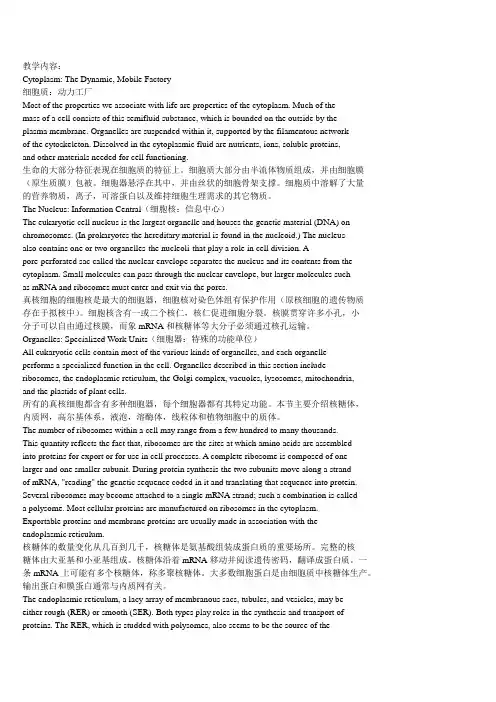
教学内容:Cytoplasm: The Dynamic, Mobile Factory细胞质:动力工厂Most of the properties we associate with life are properties of the cytoplasm. Much of themass of a cell consists of this semifluid substance, which is bounded on the outside by theplasma membrane. Organelles are suspended within it, supported by the filamentous networkof the cytoskeleton. Dissolved in the cytoplasmic fluid are nutrients, ions, soluble proteins,and other materials needed for cell functioning.生命的大部分特征表现在细胞质的特征上。
细胞质大部分由半流体物质组成,并由细胞膜(原生质膜)包被。
细胞器悬浮在其中,并由丝状的细胞骨架支撑。
细胞质中溶解了大量的营养物质,离子,可溶蛋白以及维持细胞生理需求的其它物质。
The Nucleus: Information Central(细胞核:信息中心)The eukaryotic cell nucleus is the largest organelle and houses the genetic material (DNA) on chromosomes. (In prokaryotes the hereditary material is found in the nucleoid.) The nucleusalso contains one or two organelles-the nucleoli-that play a role in cell division. Apore-perforated sac called the nuclear envelope separates the nucleus and its contents from the cytoplasm. Small molecules can pass through the nuclear envelope, but larger molecules suchas mRNA and ribosomes must enter and exit via the pores.真核细胞的细胞核是最大的细胞器,细胞核对染色体组有保护作用(原核细胞的遗传物质存在于拟核中)。
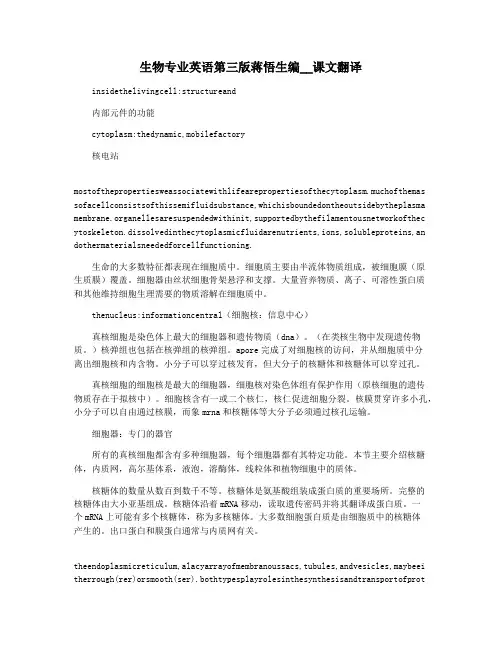
生物专业英语第三版蒋悟生编__课文翻译insidethelivingcell:structureand内部元件的功能cytoplasm:thedynamic,mobilefactory核电站mostofthepropertiesweassociatewithlifearepropertiesofthecytoplasm.muchofthemas sofacellconsistsofthissemifluidsubstance,whichisboundedontheoutsidebytheplasma anellesaresuspendedwithinit,supportedbythefilamentousnetworkofthec ytoskeleton.dissolvedinthecytoplasmicfluidarenutrients,ions,solubleproteins,an dothermaterialsneededforcellfunctioning.生命的大多数特征都表现在细胞质中。
细胞质主要由半流体物质组成,被细胞膜(原生质膜)覆盖。
细胞器由丝状细胞骨架悬浮和支撑。
大量营养物质、离子、可溶性蛋白质和其他维持细胞生理需要的物质溶解在细胞质中。
thenucleus:informationcentral(细胞核:信息中心)真核细胞是染色体上最大的细胞器和遗传物质(dna)。
(在类核生物中发现遗传物质。
)核弹组也包括在核弹组的核弹组。
apore完成了对细胞核的访问,并从细胞质中分离出细胞核和内含物。
小分子可以穿过核发育,但大分子的核糖体和核糖体可以穿过孔。
真核细胞的细胞核是最大的细胞器,细胞核对染色体组有保护作用(原核细胞的遗传物质存在于拟核中)。
细胞核含有一或二个核仁,核仁促进细胞分裂。
核膜贯穿许多小孔,小分子可以自由通过核膜,而象mrna和核糖体等大分子必须通过核孔运输。
细胞器:专门的器官所有的真核细胞都含有多种细胞器,每个细胞器都有其特定功能。
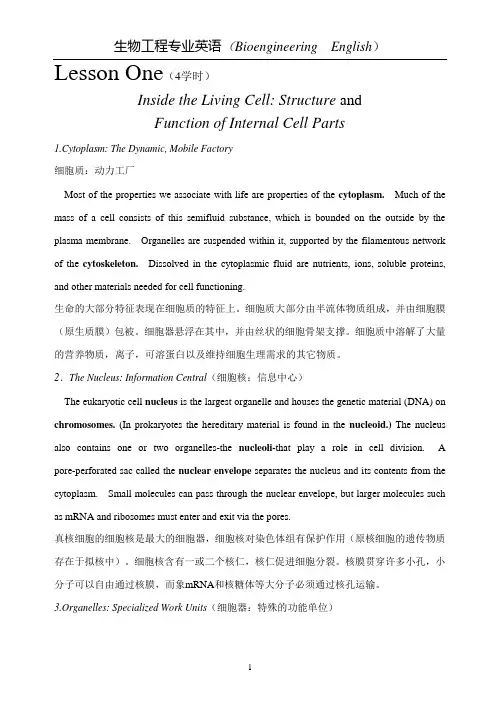
Lesson One(4学时)Inside the Living Cell: Structure andFunction of Internal Cell Parts1.Cytoplasm: The Dynamic, Mobile Factory细胞质:动力工厂Most of the properties we associate with life are properties of the cytoplasm. Much of the mass of a cell consists of this semifluid substance, which is bounded on the outside by the plasma membrane. Organelles are suspended within it, supported by the filamentous network of the cytoskeleton. Dissolved in the cytoplasmic fluid are nutrients, ions, soluble proteins, and other materials needed for cell functioning.生命的大部分特征表现在细胞质的特征上。
细胞质大部分由半流体物质组成,并由细胞膜(原生质膜)包被。
细胞器悬浮在其中,并由丝状的细胞骨架支撑。
细胞质中溶解了大量的营养物质,离子,可溶蛋白以及维持细胞生理需求的其它物质。
2.The Nucleus: Information Central(细胞核:信息中心)The eukaryotic cell nucleus is the largest organelle and houses the genetic material (DNA) on chromosomes. (In prokaryotes the hereditary material is found in the nucleoid.) The nucleus also contains one or two organelles-the nucleoli-that play a role in cell division. A pore-perforated sac called the nuclear envelope separates the nucleus and its contents from the cytoplasm. Small molecules can pass through the nuclear envelope, but larger molecules such as mRNA and ribosomes must enter and exit via the pores.真核细胞的细胞核是最大的细胞器,细胞核对染色体组有保护作用(原核细胞的遗传物质存在于拟核中)。
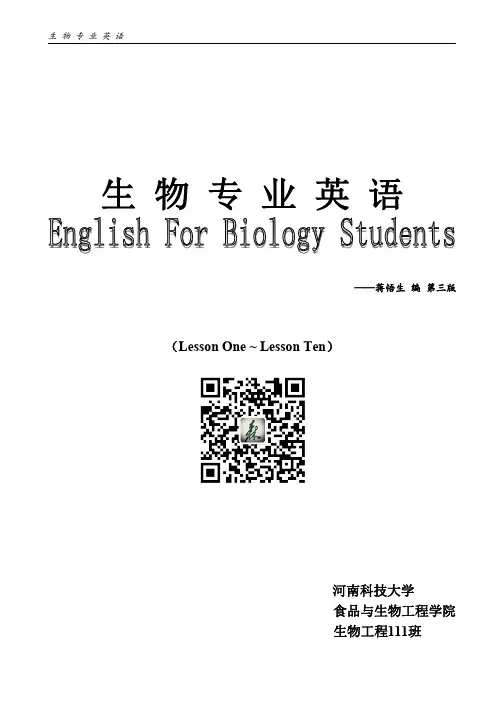
生物专业英语——蒋悟生编第三版(Lesson One~Lesson Ten)河南科技大学食品与生物工程学院生物工程111班Lesson one:Inside the Living Cell:Structure andFunction of Internal Cell PartsCytoplasm:The Dynamic,Mobile Factory细胞质:动力工厂Most of the properties we associate with life are properties of the cytoplasm.Much of the mass of a cell consists of this semifluid substance,which is bounded on the outside by the plasma anelles are suspended within it,supported by the filamentous network of the cytoskeleton.Dissolved in the cytoplasmic fluid are nutrients,ions,soluble proteins,and other materials needed for cell functioning.生命的大部分特征表现在细胞质的特征上。
细胞质大部分由半流体物质组成,并由细胞膜(原生质膜)包被。
细胞器悬浮在其中,并由丝状的细胞骨架支撑。
细胞质中溶解了大量的营养物质,离子,可溶蛋白以及维持细胞生理需求的其它物质。
The Nucleus:Information Central(细胞核:信息中心)The eukaryotic cell nucleus is the largest organelle and houses the genetic material(DNA)on chromosomes. (In prokaryotes the hereditary material is found in the nucleoid.)The nucleus also contains one or two organelles-the nucleoli-that play a role in cell division.A pore-perforated sac called the nuclear envelope separates the nucleus and its contents from the cytoplasm.Small molecules can pass through the nuclear envelope,but larger molecules such as mRNA and ribosomes must enter and exit via the pores.真核细胞的细胞核是最大的细胞器,细胞核对染色体组有保护作用(原核细胞的遗传物质存在于拟核中)。
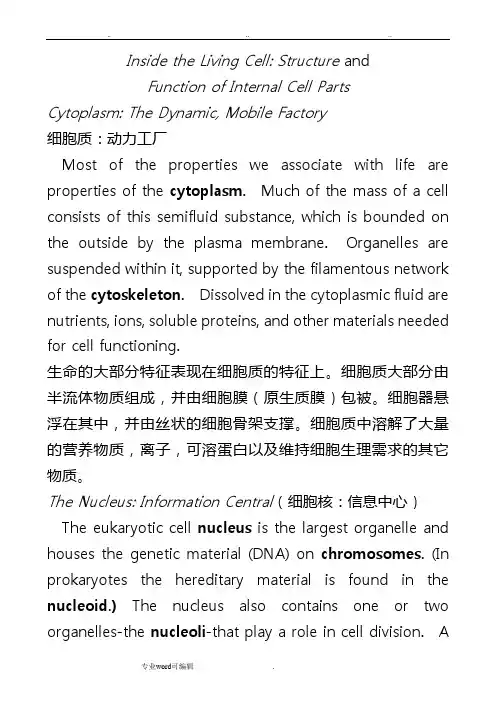
Inside the Living Cell: Structure andFunction of Internal Cell Parts Cytoplasm: The Dynamic, Mobile Factory细胞质:动力工厂Most of the properties we associate with life are properties of the cytoplasm. Much of the mass of a cell consists of this semifluid substance, which is bounded on the outside by the plasma membrane. Organelles are suspended within it, supported by the filamentous network of the cytoskeleton. Dissolved in the cytoplasmic fluid are nutrients, ions, soluble proteins, and other materials needed for cell functioning.生命的大部分特征表现在细胞质的特征上。
细胞质大部分由半流体物质组成,并由细胞膜(原生质膜)包被。
细胞器悬浮在其中,并由丝状的细胞骨架支撑。
细胞质中溶解了大量的营养物质,离子,可溶蛋白以及维持细胞生理需求的其它物质。
The Nucleus: Information Central(细胞核:信息中心)The eukaryotic cell nucleus is the largest organelle and houses the genetic material (DNA) on chromosomes. (In prokaryotes the hereditary material is found in the nucleoid.) The nucleus also contains one or two organelles-the nucleoli-that play a role in cell division. Apore-perforated sac called the nuclear envelope separates the nucleus and its contents from the cytoplasm. Small molecules can pass through the nuclear envelope, but larger molecules such as mRNA and ribosomes must enter and exit via the pores.真核细胞的细胞核是最大的细胞器,细胞核对染色体组有保护作用(原核细胞的遗传物质存在于拟核中)。
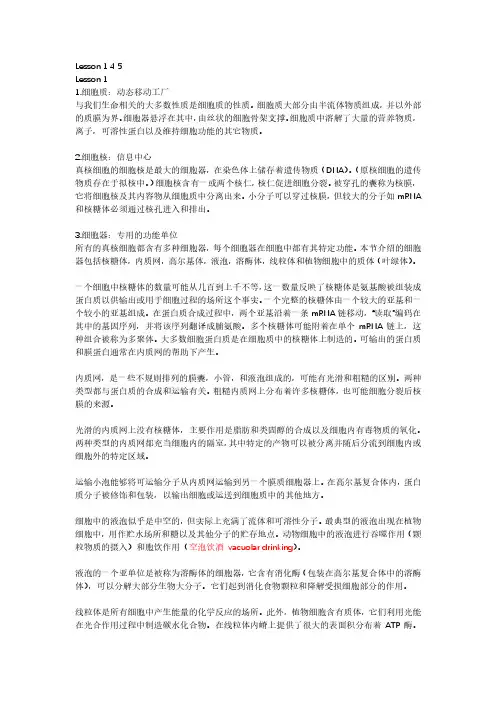
Lesson 1 4 5Lesson 11.细胞质:动态移动工厂与我们生命相关的大多数性质是细胞质的性质。
细胞质大部分由半流体物质组成,并以外部的质膜为界。
细胞器悬浮在其中,由丝状的细胞骨架支撑。
细胞质中溶解了大量的营养物质,离子,可溶性蛋白以及维持细胞功能的其它物质。
2.细胞核:信息中心真核细胞的细胞核是最大的细胞器,在染色体上储存着遗传物质(DNA)。
(原核细胞的遗传物质存在于拟核中。
)细胞核含有一或两个核仁,核仁促进细胞分裂。
被穿孔的囊称为核膜,它将细胞核及其内容物从细胞质中分离出来。
小分子可以穿过核膜,但较大的分子如mRNA 和核糖体必须通过核孔进入和排出。
3.细胞器:专用的功能单位所有的真核细胞都含有多种细胞器,每个细胞器在细胞中都有其特定功能。
本节介绍的细胞器包括核糖体,内质网,高尔基体,液泡,溶酶体,线粒体和植物细胞中的质体(叶绿体)。
一个细胞中核糖体的数量可能从几百到上千不等,这一数量反映了核糖体是氨基酸被组装成蛋白质以供输出或用于细胞过程的场所这个事实。
一个完整的核糖体由一个较大的亚基和一个较小的亚基组成。
在蛋白质合成过程中,两个亚基沿着一条mRNA链移动,“读取”编码在其中的基因序列,并将该序列翻译成脯氨酸。
多个核糖体可能附着在单个mRNA链上,这种组合被称为多聚体。
大多数细胞蛋白质是在细胞质中的核糖体上制造的。
可输出的蛋白质和膜蛋白通常在内质网的帮助下产生。
内质网,是一些不规则排列的膜囊,小管,和液泡组成的,可能有光滑和粗糙的区别。
两种类型都与蛋白质的合成和运输有关。
粗糙内质网上分布着许多核糖体,也可能细胞分裂后核膜的来源。
光滑的内质网上没有核糖体,主要作用是脂肪和类固醇的合成以及细胞内有毒物质的氧化。
两种类型的内质网都充当细胞内的隔室,其中特定的产物可以被分离并随后分流到细胞内或细胞外的特定区域。
运输小泡能够将可运输分子从内质网运输到另一个膜质细胞器上。
在高尔基复合体内,蛋白质分子被修饰和包装,以输出细胞或运送到细胞质中的其他地方。
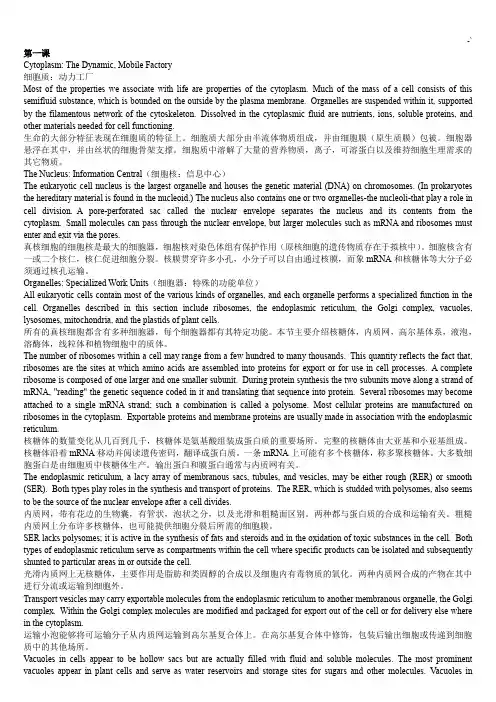
第一课Cytoplasm: The Dynamic, Mobile Factory细胞质:动力工厂Most of the properties we associate with life are properties of the cytoplasm. Much of the mass of a cell consists of this semifluid substance, which is bounded on the outside by the plasma membrane. Organelles are suspended within it, supported by the filamentous network of the cytoskeleton. Dissolved in the cytoplasmic fluid are nutrients, ions, soluble proteins, and other materials needed for cell functioning.生命的大部分特征表现在细胞质的特征上。
细胞质大部分由半流体物质组成,并由细胞膜(原生质膜)包被。
细胞器悬浮在其中,并由丝状的细胞骨架支撑。
细胞质中溶解了大量的营养物质,离子,可溶蛋白以及维持细胞生理需求的其它物质。
The Nucleus: Information Central(细胞核:信息中心)The eukaryotic cell nucleus is the largest organelle and houses the genetic material (DNA) on chromosomes. (In prokaryotes the hereditary material is found in the nucleoid.) The nucleus also contains one or two organelles-the nucleoli-that play a role in cell division. A pore-perforated sac called the nuclear envelope separates the nucleus and its contents from the cytoplasm. Small molecules can pass through the nuclear envelope, but larger molecules such as mRNA and ribosomes must enter and exit via the pores.真核细胞的细胞核是最大的细胞器,细胞核对染色体组有保护作用(原核细胞的遗传物质存在于拟核中)。
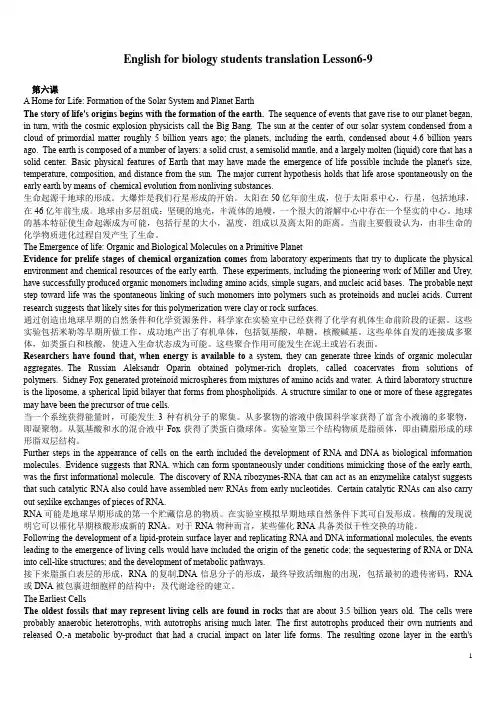
English for biology students translation Lesson6-9第六课A Home for Life: Formation of the Solar System and Planet EarthThe story of life's origins begins with the formation of the earth. The sequence of events that gave rise to our planet began, in turn, with the cosmic explosion physicists call the Big Bang. The sun at the center of our solar system condensed from a cloud of primordial matter roughly 5 billion years ago; the planets, including the earth, condensed about 4.6 billion years ago. The earth is composed of a number of layers: a solid crust, a semisolid mantle, and a largely molten (liquid) core that has a solid center. Basic physical features of Earth that may have made the emergence of life possible include the planet's size, temperature, composition, and distance from the sun. The major current hypothesis holds that life arose spontaneously on the early earth by means of chemical evolution from nonliving substances.生命起源于地球的形成。
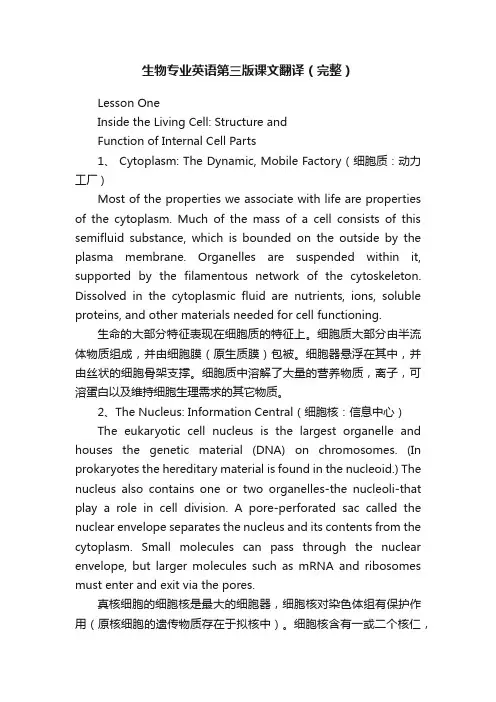
生物专业英语第三版课文翻译(完整)Lesson OneInside the Living Cell: Structure andFunction of Internal Cell Parts1、 Cytoplasm: The Dynamic, Mobile Factory ( 细胞质:动力工厂 )Most of the properties we associate with life are properties of the cytoplasm. Much of the mass of a cell consists of this semifluid substance, which is bounded on the outside by the plasma membrane. Organelles are suspended within it, supported by the filamentous network of the cytoskeleton. Dissolved in the cytoplasmic fluid are nutrients, ions, soluble proteins, and other materials needed for cell functioning.生命的大部分特征表现在细胞质的特征上。
细胞质大部分由半流体物质组成,并由细胞膜(原生质膜)包被。
细胞器悬浮在其中,并由丝状的细胞骨架支撑。
细胞质中溶解了大量的营养物质,离子,可溶蛋白以及维持细胞生理需求的其它物质。
2、The Nucleus: Information Central(细胞核:信息中心)The eukaryotic cell nucleus is the largest organelle and houses the genetic material (DNA) on chromosomes. (In prokaryotes the hereditary material is found in the nucleoid.) The nucleus also contains one or two organelles-the nucleoli-that play a role in cell division. A pore-perforated sac called the nuclear envelope separates the nucleus and its contents from the cytoplasm. Small molecules can pass through the nuclear envelope, but larger molecules such as mRNA and ribosomes must enter and exit via the pores.真核细胞的细胞核是最大的细胞器,细胞核对染色体组有保护作用(原核细胞的遗传物质存在于拟核中)。
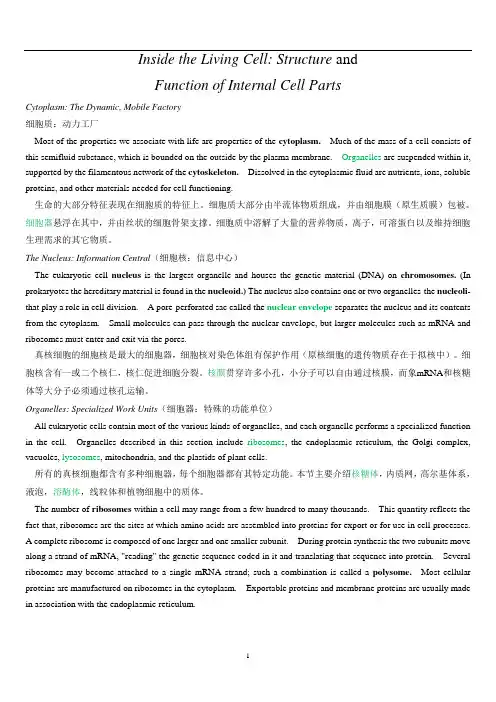
Inside the Living Cell: Structure andFunction of Internal Cell PartsCytoplasm: The Dynamic, Mobile Factory细胞质:动力工厂Most of the properties we associate with life are properties of the cytoplasm. Much of the mass of a cell consists of this semifluid substance, which is bounded on the outside by the plasma membrane. Organelles are suspended within it, supported by the filamentous network of the cytoskeleton. Dissolved in the cytoplasmic fluid are nutrients, ions, soluble proteins, and other materials needed for cell functioning.生命的大部分特征表现在细胞质的特征上。
细胞质大部分由半流体物质组成,并由细胞膜(原生质膜)包被。
细胞器悬浮在其中,并由丝状的细胞骨架支撑。
细胞质中溶解了大量的营养物质,离子,可溶蛋白以及维持细胞生理需求的其它物质。
The Nucleus: Information Central(细胞核:信息中心)The eukaryotic cell nucleus is the largest organelle and houses the genetic material (DNA) on chromosomes. (In prokaryotes the hereditary material is found in the nucleoid.) The nucleus also contains one or two organelles-the nucleoli-that play a role in cell division. A pore-perforated sac called the nuclear envelope separates the nucleus and its contents from the cytoplasm. Small molecules can pass through the nuclear envelope, but larger molecules such as mRNA and ribosomes must enter and exit via the pores.真核细胞的细胞核是最大的细胞器,细胞核对染色体组有保护作用(原核细胞的遗传物质存在于拟核中)。
Lesson One(4学时)Inside the Living Cell: Structure andFunction of Internal Cell Parts教学目的:使学生掌握细胞的组成结构(各种细胞器以及它们在细胞中的位置),Cytoplasm: The Dynamic, Mobile Factory细胞质:动力工厂Most of the properties we associate with life are properties of the cytoplasm. Much of the mass of a cell consists of this semifluid substance, which is bounded on the outside by the plasma membrane. Organelles are suspended within it, supported by the filamentous network of the cytoskeleton. Dissolved in the cytoplasmic fluid are nutrients, ions, soluble proteins, and other materials needed for cell functioning.生命的大部分特征表现在细胞质的特征上。
细胞质大部分由半流体物质组成,并由细胞膜(原生质膜)包被。
细胞器悬浮在其中,并由丝状的细胞骨架支撑。
细胞质中溶解了大量的营养物质,离子,可溶蛋白以及维持细胞生理需求的其它物质。
The Nucleus: Information Central(细胞核:信息中心)The eukaryotic cell nucleus is the largest organelle and houses the genetic material (DNA) on chromosomes. (In prokaryotes the hereditary material is found in the nucleoid.) The nucleus also contains one or two organelles-the nucleoli-that play a role in cell division. A pore-perforated sac called the nuclear envelope separates the nucleus and its contents from the cytoplasm. Small molecules can pass through the nuclear envelope, but larger molecules such as mRNA and ribosomes must enter and exit via the pores.真核细胞的细胞核是最大的细胞器,细胞核对染色体组有保护作用(原核细胞的遗传物质存在于拟核中)。
Lesson One(4学时)Inside the Living Cell: Structure andFunction of Internal Cell Parts教学目的:使学生掌握细胞的组成结构(各种细胞器以及它们在细胞中的位置),以及结构与功能之间的关系。
各细胞器及功能相关英语词汇以及主要用法。
教学重点:各细胞器的概念和功能,及相关英语词汇的掌握教学难点:专业英语词汇的记忆讲授方法:以学生翻译为主,老师讲解相关专业知识辅助学生理解授课时间:3月22日;3月29日教学内容:Cytoplasm: The Dynamic, Mobile Factory细胞质:动力工厂Most of the properties we associate with life are properties of the cytoplasm. Much of the mass of a cell consists of this semifluid substance, which is bounded on the outside by the plasma membrane. Organelles are suspended within it, supported by the filamentous network of the cytoskeleton. Dissolved in the cytoplasmic fluid are nutrients, ions, soluble proteins, and other materials needed for cell functioning.生命的大部分特征表现在细胞质的特征上。
细胞质大部分由半流体物质组成,并由细胞膜(原生质膜)包被。
细胞器悬浮在其中,并由丝状的细胞骨架支撑。
细胞质中溶解了大量的营养物质,离子,可溶蛋白以及维持细胞生理需求的其它物质。
九年级英语单词表 Unit 1flashcard[‘flæʃkɑ:d](教学用的)抽认卡vocabulary[və'kæbjuləri]字汇aloud[ə'laud]大声地、出声地pronunciation [prə'nʌnsi'eiʃən]发音、发音法specific [spi'sifik] 明确的、具体的memorize [‘meməraiz] 记住、熟记grammar [’ɡræmə] 语法、语法规则differently [‘dɪfərəntlɪ] 不同的、有区别的frustrate [’frʌstreit] 使失望、使沮丧、使厌烦frustrating [frʌ‘streɪtɪŋ]令人失望的quickly [’kwɪklɪ] 快地、迅速地add [æd] 补充、继续说pronounce [prə‘nauns] 发…音、(清晰地)吐(字等) spoken[’spəʊkən] 口语的、口头的slowly [‘sləʊlɪ] 慢地、缓慢地mistake [mɪ’steɪkən] 错误、过失make mistakes<>犯错、出错comma [‘kɔmə] [’kɑmə]逗号challenge [‘tʃæləndʒ] 挑战solution [sə’lu:ʃən] 解决、解答later on<>以后、随后realize [‘riəlaiz] 认识到、了解到matter [’mætə] 重要、要紧、有关系it doesn't matter<>没关系afraid [ə‘freid] 害怕的、犯愁的be afraid to 害怕去做、不敢去做laugh ag 嘲笑、取笑complete [kəm'pli:t] 完整的、完全的secret ['si:krit] 秘诀、诀窍、秘密learner ['lɜ:nə] 学习者take notes 做笔记、做记录team [ti:m] 学期impress [im’pres] 使感动、使印象深刻trouble [‘trʌbəl] 困难、苦恼、忧虑fast [fɑ:st] [fæst] 快地、迅速地look up<>查阅soft [sɔft] 柔软impress [im'pres] 印象make up<> 组成essay [’esei] 文章(尤指短文、小品文、散文)deal [di:l] 处理、应付deal with<> 处理、应付unless [ʌn‘les] 如果不、除非unfair [‘ʌn’feə] 不公平的、不公正的solve [sɑlv, sɔlv] 解决、解答regard [ri’ɡɑ:d] 将…视为duty [‘dju:ti] 责任、义务easily [’i:zili] 容易地、简单地influence [‘influəns]影响、对…起作用be angry with<> 生…的气、对…感到气愤go by<> 过去、消逝friendship [’frendʃip] 友谊、友情、友爱lose [lu:z] 失去、丧失disagreement [‘dɪsə’gri:mənt] 分歧、不一致、不合development [di’veləpmənt] 发育、发展、进展adult [ə‘dʌlt, ’ædʌlt] 成年人try one’s best 尽力做…unimportant [‘ʌnɪm’pɔ:tnt] 不重要的face [feis] 面临、面对、正视soldier [‘səuldʒə]军人、士兵break off 突然中止、中断psychologist[saɪ’kɔlədʒɪst] 心理学者Pierre<>皮埃尔Antonio<>安东尼奥Lillian<>莉莲Stephen<>史蒂芬Unit 2used to<>过去经常、以前常常(后接不定式) airplane [‘ɛəplein] 飞机terrify [’terifai] 使害怕、使恐怖be terrified of<>非常害怕的、极度恐惧的go to sleep<>去睡觉on<>开着的、接通的、工作着的insect [‘insekt] 昆虫candy ['kændi] 糖果chew [tʃu:] 咀嚼gum [ɡʌm] 口香糖chat [tʃæt] 聊天、闲谈daily [‘deili] 每日的、日常的comic [’kɔmik] [‘kɑmɪk]连环图画death [deθ]死亡cause [kɔ:z] 造成、使发生himself [him’self] 他自己、他本身patient [’peiʃənt] 有耐心的、忍耐的in the end<> 最后、终于decision [di‘siʒən] 决定make a decision<> 作决定head teacher<> 校长to one's surprise [sə’praiz] 令某人惊奇的是…exactly [ɪg‘zæktli] 正、恰恰even though<> 即使、纵然、尽管no longer<> 不再、已不take pride in<> 对…感到自豪attention [ə’tenʃən] 注意、专心、留心pay attention to<> 注意give up<> 放弃waste [weist] 浪费、滥用Murray<> 默里(姓氏)Unit 3pierce [piəs] 刺穿license [‘laisəns] 执照、许可证silly [’sili] 愚蠢的、傻的earring [‘iə’riŋ,‘ɪrɪŋ] 耳环instead of<> 代替、而不是stay up<> 熬夜、不睡觉concentrate [’kɔnsəntreit] 集中、聚集concentrate on<> 专注于、全神贯注study [‘stʌdi] 研究、学习design [di’zain] 设计、构思present [‘prezənt] 目前;现在at present<> 目前、现在opportunity [’ɔpə‘tju:niti] 机会、时机volunteer [’vɔlən‘tiə] 自愿(做某事)、志愿者local [’ləukəl] 地方的、当地的experience [iks‘piəriəns] 经历、体验member [’membə] 会员、成员mess [mes] 混乱、脏乱old people's home<> 老人院sleepy ['sli:pi] 困倦的、不活跃的reply [ri'plai] 回答、答复newsletter [‘nu:z’letə] 时事通讯、简报obey[əu‘bei] 服从、顺从in the way<>挡道的、妨碍人的achieve [ə’ʃi:v] 完成、实现race [reis] 赛跑、比赛、与…比赛、参加赛跑realistic [‘riə’listik] 现实的、注重实际的taught [tɔ:t] teachr的过去式或过去分词importance [im‘pɔ:təns] 重要性care [kɛə]照料care about<>担心、关心succeed [sək’si:d] 成功、达到、完成point [pɔint] 要点、论点Kathy<>凯西(女名)Unit 4million ['miljən] 百万medical ['medikəl] 医学的、医疗的research [ri‘sə:tʃ] 研究、调查tie [taɪ](=necktie) 领带worry ['wʌri] 烦恼、忧虑what if<>如果...将会怎么样pimple [’pɪmpəl] 小脓胞、丘疹energetic[‘enə’dʒetik] 有活力的、精力充沛的confident [‘kɔnfidənt] 自信的、有把握的permission [pə’miʃən] 许可、允许、准许herself [hə:’self] 她自己bother [‘bɔðə] 使烦恼、打扰not...in the slightest<>一点也不annoy[ə’nɔi] 使生气、使烦恼fairly [‘fɛəli] 相当地、还算、公平地plenty ['plenti] 充足、大量plenty of<>很多、足够多get along wiht<>与…相处circle [‘sə:kl] (有共同的兴趣人形成的)圈子、阶层listener [’lisnə] 听者、收听者knowledgeable [‘nɑ:lɪdʒəbəl] 有见识的represent [’repri‘zent] 代表、表示let...down...<> 使…失望或沮丧come up with<>提出、想出(主意、回答等)rest [rest] 休息aid [eid] 帮助、救助、援助、救护first-aid<>急救nearby [’niəbai] 附近的、近处的shelf [ʃelf] 架子、(书厨、柜子等的)搁板come out<>出来、出版、发表cover [‘kʌvə] 覆盖、遮掩press [pres] 挤、压、按deep [di:p] 深的downstairs ['daun'stɛəz] 在楼下、顺楼梯而下correct [kə'rekt] 对的、正确的、准确的burn [bə:n,bɜ:(r )n] 烧伤、烧坏knee [ni:] 膝盖pain [pein] 疼、疼痛hurt [hə:t] (身体部位)感到疼痛、(使)受伤offer [‘ɔfə] 提供refuse [ri’fju:z] 拒绝;回绝helpful [‘helpful]有帮助的、有用的treat [tri:t] 对待burn [bɜ:(r)n] 炎、热或酸所造成的伤害或伤痕Spotty [’spɔti:] 多斑点的、发疹的(文中用作人名) Unit 5belong [bi'lɔŋ] 属于belong to<>属于author ['ɔ:θə,'ɔːθə(r)] 作家picnic ['piknik] (自带食物的)郊游野餐hair band [bænd] 发带possibly ['pɔsəbli] 可能地、也许drop [drɔp] 落下、掉下symphony ['simfəni] 交响乐交响曲optometrist [ɔp'tɔmitrist] 验光师、配镜师appointment [ə‘pɔintmənt] 约会、约定crucial [’kru:ʃəl] 关键的、至关重要的make up<> 形成、组成、构成final [‘fainəl,’faɪnl] 最后的、最终的anxious [‘æŋkʃəs] 忧虑的、焦虑的、不安的worried [’wʌrɪd] 烦恼的、焦虑的owner [‘əunə] 所有者、物主Oxford University [ 'ɔksfəd 'ju:ni'və:siti] 牛津大学chase [tʃeis] 追逐、追赶sky [skai] 天、天空helicopter ['helikɔptə] 直升机creature ['kri:tʃə] 生物、动物catch [kætʃ] 赶上(车船等)、捕获unhappy [ʌn'hæpi:] 不快乐的、不愉快的extremely [iks'tri:mli] 极其、非常interview ['intəvju:] 面试、采访、会见noise [nɔiz] 噪音、喧闹声、嘈杂声wind [wind] 风neighbor ['neibə] 邻居footstep ['futstep] 脚步声、足迹garbage ['ɡɑ:bidʒ] 垃圾、废料mystery ['mistəri] 神秘的事物、不可思议的事物、谜director [di'rektə] 主管、主任monkey ['mʌŋki] 猴子escape [is'keip] 逃跑、逃走bark [bɑ:k] (狗等)吠声、叫声smell [smel] 气味finger ['fiŋɡə] 手指lift [lift] 举起、抬起、提升stone [stəun] 石头、石块ant [ænt] 蚂蚁ocean ['əuʃən] 海洋dishonest [dɪs'ɔnɪst] 不诚实的pretend [pri'tend] 假装use up<>用完、用光、耗尽attempt [ə'tempt] 试图、企图Hemingway<>海明威Mark Twain ['mɑ:k'twein] 马克吐温Fred 弗雷德Review of units 1-5net [net] 网、网状物turn off<>关掉polar bear ['pəulə] 北极熊Vietnam ['viət'næm] 越南Unit 6prefer [pri'fə:] 更喜爱、更喜欢lyric ['lirik] 歌词、抒情歌词gentle ['dʒentl] 轻柔的、柔和的dislike [dis'laik] 不喜欢remind [ri'maind] 提醒、使记起heart [hɑ:t] 心、内心string [striŋ] 细绳、线sink [siŋk] 下沉、沉没Yellow River ['rivə] 黄河fisherman ['fiʃə'mən] 渔民、渔夫latest ['leitist] 最近的entertainment ['entə'teinmənt] 娱乐、乐趣、快乐feature ['fi:tʃə] 特点、特征photography [fə'tɔgrəfi:] 摄影、照相gallery ['ɡæləri] 美术馆、画廊photographer [fɵ'tɔgrəfə] 摄影者、摄影师display [dis'plei] 展览、陈列on display<>展览、陈列photograph ['fəutəɡrɑ:f] 照片、相片interest ['intrist] 引起…关注、使…感兴趣class [klɑ:s] 等级、级别whatever [hwɔt'evə] 不管什么、无论什么、任何(事物) miss [mis] 错过、遗漏suggest [sə'dʒest] 显示、间接表明、暗示energy ['enədʒi] 活力、力量okay ['əu'kei] =OK)好的pro [prəʊ] 赞成的观点con [kɔn] 反对的观点honest ['ɔnist] 诚实的、真诚的course [kɔ:s] 课程suit [sju:t] 适合、使感到满意suit sb.(fine) <>(口语)(很)合某人口味expect [iks'pekt] 期待、预料sweet [swi:t] 甜的taste [teist] 品尝、尝起来to be honest ['ɔnist] (作插入语)老实说、实在的be bad for<>对...有害actually ['æktʃu:əli] 实际上、说实在的fry [frai] 油炸、油煎mainly ['meɪnli] 主要地、首要地stay away from<>与……保持距离be in agreement [ə'ɡri:mənt] 意见一致itself [it'self] 它本身laboratory [lə'bɔrətəri] 实验室type [taip] 类型、种类cancer ['kænsə] 癌症barbecue ['bɑ:bikju:] 户外烤肉餐、(尤指户外的)烤肉increase [in'kri:s] 增加、增大risk [risk] 危险、风险biscuit ['biskit] 饼干main [mein] 主要的、首要的exclamation ['eksklə'meɪʃən] 感叹号tag question<>附加疑问句contraction [kən'trækʃən] 缩略词、缩略形式tasty ['teɪsti:] 味道好的、味美可口的vegetarian ['vedʒɪ'teəri:ən] 素食主义者shock [ʃɔk] 使……震惊Carmen 卡门Dan Dervish 丹.德威什Unit 7tiring ['taɪərɪŋ] 引起疲劳的、累人的educational ['edʒə'keɪʃənəl] 教育的、有教育意义的peaceful ['pi:sful] 平静的、宁静的、和平的fascinating ['fæsineitiŋ] 迷人的、有极大吸引力的thrilling ['θrɪlɪŋ] 令人激动的、令人震颤的take it easy<>从容、轻松、不紧张Florida ['flɔrɪdə] 佛罗里达州trek [trek] 旅行、长途跋涉Amazon ['æməzən] 亚马孙河jungle ['dʒʌŋɡl] 热带丛林fall [fɔ:l] 瀑布Niagara Falls [nai\æɡərə] 尼加拉大瀑布touristy ['tuəristi] 游客很多的、游客常去的、适合游览的spotlight ['spɔtlait] 公众注意的中心consider [kən'sidə] 考虑、思考、认为lively ['laivli] 充满活力的、生气勃勃的、活泼的sight [sait] 名胜、风景including [in`klu:din] 包含、包括tower ['tauə] 塔、塔楼Eiffel Tower ['aɪfəl] 埃菲尔铁塔cathedral [kə'θi:drəl] 总教堂、主教教堂、大教堂Notre Dame Cathedral ] [¸nəutrə´dɑ:m] 巴黎圣母院church [tʃə:tʃ] 教堂convenient [kən'vi:njənt] 便利的、方便的underground ['ʌndəɡraund] 地下的general ['dʒenərəl] 一般事物、一般原则in general<>通常、大体上、一般而言wine [wain] 葡萄酒、酒translate [træns'leit] 翻译pack [pæk] 把…打包、把…装箱light [lait] 轻的wonderful ['wʌndəful] 令人惊奇的Ace Travel [eis, 'trævəl] 旅游社名eastern ['i:stən] 东部的、来自东部的provide [prə'vaid] 提供、供应、供给firm [fə:m] 公司spot [spɔt] 地点;场所Confucius [kən'fju:ʃəs] 孔子sail [seil] 航行、在…上航行Pacific [pə'sɪfɪk] 太平洋finding ['faindiŋ] 发现、发现物、调查的结果thousands of ['θaʊzəndz] 数以千计的、许许多多的as soon as possible ['pɔsəbl] 尽快地continue [kən'tinju] 继续、坚持下去programming ['prəuɡræmiŋ] 编程translator [træns'leɪtə] 翻译员report [ri'pɔ:t] 报道、报告willing ['wiliŋ] 乐意的、自愿的、心甘情愿的be willing to<>乐意(做某事)quite a few<>相当多、不少dream [dri:m] 做梦、梦到、梦想、幻想dream of<>梦想、幻想、向往sportspeople<>爱运动的人、运动员conclusion [kən'klu:ʒən] 结论hold on to [həuld] 继续、坚持、保持attitude ['ætitju:d] 态度Unit 8clean up<>(把…)打扫干净、(把…)收拾整齐hunger ['hʌŋɡə] 饿、饥饿homeless ['həʊmlɪs] 无家可归的cheer [tʃɪə(r),tʃɪr] 使振奋、使高兴起来give out<>分发;发放clean-up<>打扫、清洁sign [sain] 标牌、招牌advertisement [əd'və:tismənt] 广告、广告活动put off<>推迟;拖延set摆放、放置set up<>创建;开办establish [is'tæbliʃ] 建立、建造、设立think up<>想出major ['meidʒə] 主要的、重大的commitment [kə'mitmənt] 奉献;忠诚、辛劳elementary ['eli'mentəri] 基础的;小学的veterinarian ['vetərə'neəri:ən] 兽医coach [kəutʃ] 训练;指导take after<>(在外貌、性格等方面)与(父母等)相像fix [fiks] 修理;修补fix up<>修理;修补repair [ri'pɛə] 修理;修补similar ['similə] 相似的;相仿的put up<>张贴;搭建ask for<>要求;请求hand out<>分发;发放call-in<>(=phone-in)听(观)众来电直播节目strategy ['strætidʒi] 方法;策略work out<>产生结果;发展、成功website [´websait] (互联网的)站点disabled [dɪs'eɪbəld] 肢体残疾的organization ['ɔ:ɡənai'zeiʃən] 组织;机构、系统fill [fil] 装满;填满pleasure ['pleʒə] 愉快;高兴blind [blaind] 盲的deaf [def] 聋的unable [ʌn'eɪbəl] 不能的;不会的cannot ['kænɔt] (=con't)imagine [I'mædʒin] 想象shut [ʃʌt] 关上(门、窗、盖等)turn off关电器carry ['kæri] 搬运;携带help(sb.)out<>帮组(某人)解决困难specially ['speʃəlɪ] 特意地;专门地fetch [fetʃ] 拿来;青来at once<>立即;马上support [sə'pɔ:t] 支持;帮组appreciate [ə'pri:ʃieit] 感激donation [dəu'neiʃən] 捐赠物;捐赠part of speech [spi:tʃ] 词性;词类pronoun ['prəunaun] 代词adverb ['ædvə:b,'ædvɜːb] 副词preposition ['prepə'ziʃən] 介词conjunction [kən'dʒʌŋkʃən] 连词donate [dəu'neit] 捐赠;赠送Jimmy 吉米(男名)Sally 萨利(女名)Unit 9invent [in'vent] 发明;创造calculator ['kælkjuleitə] 计算器be used for<>用来做……scoop [sku:p] 用勺舀、勺子、球形勺、长柄勺adjustable [ə'dʒʌstəbl] 可调整的heel [hi:l] (足)跟;(鞋、袜等的)后跟battery ['bætəri] 电池operate ['ɔpəreit] 操作;作业battery-operated<>电池供电的slipper ['slipə] 拖鞋heat [hi:t] 加热;使变热bulb [bʌlb] 电灯泡;电灯light bulb<>电灯泡microwave ['maɪkrə'weɪv] 微波microwave oven ['ʌvən] 微波炉crispy ['krispi] 脆的;易碎的salty ['sɔ:lti:] 咸的;含盐的sour ['sauə] 酸的;酸味的by mistake [mis'teik] 错误的chef [ʃef] 厨师sprinkle ['spriŋkl] 撒(粉末状物);洒(液体)by accident ['æksidənt] 偶然地;意外地beverage ['bevəridʒ] 饮料according to [ə'kɔ:diŋ] 根据;据…所说ancient ['einʃənt] 古代的;古老的legend ['ledʒənd] 传说;传奇故事Shen Nong<>神农bush [buʃ] 灌木;灌木丛fall into<>落入;陷入remain [ri'mein] 留下;被遗留、剩余、保持不变notice ['nəutis] 注意到;察觉到produce [prə'dju:s] 生产;制造pleasant ['plezənt] 合意的;令人愉快的、讨人喜欢的mixture ['mikstʃə] 混合;混合剂in this way<>这样pie [pai] 馅饼flying ['flaɪɪŋ] 飞盘bakery ['beɪkəri:] 面包店Bridgeport ['brɪdʒ'pɔ:t] 布里奇波特市Connecticut [kə'netikət] 康涅狄格州throw [θrəu] 投;抛taste [teist] 味道;风味lemon ['lemən] 柠檬cookie ['kuki] 曲奇饼;小甜饼abacus ['æbəkəs, ə'bækəs] 算盘binoculars [bai'nɔkjuləz] 双筒望远镜century ['sentʃuri] >世纪;百年rank [ræŋk] 顺序;级别active ['æktiv] 活动的;积极的、活泼的indoors ['indɔ:z] 在户内create [kri'eit] 创造;创作、创建wooden ['wudn] 木制的knock [nɔk] 敲;击;碰撞knock into<>与……相撞divide [di'vaid] 分开;划分aim [eim] 目标;目的basket ['bɑ:skit] 篮;框metal ['metl] 金属hoop [hu:p, hʊp] 环;圈;篮圈shoot [ʃu:t] 投篮;射击below [bi'ləu] 在……的下面、低于…backboard ['bækbɔ:d] 篮板;背板guide [ɡaid] 指导;带领towards [tɔ:dz, təʊrdz, tə'wɔ:dz] 向着;朝着court [kɔ:t] 球场Berlin [bɜ:'lɪn] 柏林develop [di'veləp] (使)发展、(使)成长、(使)发达popularity ['pɔpjə'lærɪti:] 普及;流行rise [raiz] 上升、达到较高水平等risen ['rizn] rise的过去分词worldwide ['wə:ldwaid] 世界范围的;世界性的association [ə'səuʃi'eiʃən] 协会equipment [I'kwipmənt] 装备;器材Chelsea Lanmon 切尔西·来蒙Jayce Coziar 杰斯·克里亚Jamie Ellsworth 杰米·埃尔斯沃思Julie Thompson 朱莉·汤普森Crum 克拉姆(姓氏)James Naismith詹姆斯·奈史密斯(篮球运动创始人)Unit 10by the time<>到……时候、到…之前gotten ['ɡɔtn] get的过去分词oversleep ['əʊvə'sli:p] 睡过头、睡得过久go off<>发出响声rush [rʌʃ] 冲;奔run off<>跑掉;迅速离开on time<>准时lock [lɔk] 锁上;锁relative ['relətiv] 亲属;亲戚broke [brəʊk] break的过去式break down<>停止运行;出故障fool [fu:l] 白痴;欺骗costume ['kɔstju:m] (特定场合穿的)成套服装;戏装embarrassed [ɪm'bærəst] 尴尬的;为难的empty ['empti] 空的;排空show up<>出席;露面exhausted [ɪg'zɔ:stɪd] 极其疲惫的、精疲力竭的April Fool's Day<>愚人节announce [ə'nauns] 宣布、宣告Mars [mɑ:(r)z] 火星convincing [kən'vɪnsɪŋ] 令人信服的、有说服力的panic ['pænik] 恐慌;惊恐set off<>激起;引起authority [ɔ:'θɔriti] 权威机构;行政管理机构reveal [ri'vi:l] 揭示;揭露hoax [həʊks] 骗局;恶作剧、玩笑flee [fli:] 逃;逃走fled [fled] flee的过去式及过去分词spaghetti [spə'ɡeti] 意大利式细面条farmer ['fɑ:mə] 农夫;农场主sell out<>卖完;售完girlfriend ['gɜ:l'frend] 女朋友marry ['mæri] 嫁;娶;与……结婚thrill [θril] (使)非常激动、(使)非常紧张get married<>结婚ending ['endiŋ] 结局;结尾embarrassing [ɪm'bærəsɪŋ] 令人尴尬的、令人为难的a piece of<>一片、一块Orson 奥森·韦尔斯Review of units 6-10Halloween ['hæləʊ'i:n] 万圣节前夕Holland [hɑ:ləud] 荷兰Qomolangma ['tʃumu'lʌŋmʌ] 珠穆朗玛峰Unit11restroom [ 'rest'ru:m] 公共厕所、休息室shampoo [ʃæm'pu:] 洗发剂、香波drugstore ['drʌɡstɔ:] 杂货店;药店café ['kæfei] 咖啡馆;小餐馆department [di'pɑ:tmənt] 部门;局;部department store [di'pɑ:tmənt] 百货商店、百货公司escalator ['eskə'leɪtə] 电动扶梯、自动扶梯magic ['mædʒik] 魔术;魔力fresh [freʃ] 新鲜的、清新的block [blɔk] 街区;街段oak [əuk] 橡树;橡木uncrowded ['ʌn'kraudid] 不拥挤的;宽敞slide [slaid] 滑道;滑动装置water slide<>水滑道clown [klaun] 小丑、丑角staff [stɑ:f] 职员;工作人员、全体职员organized ['ɔ:ɡənaizd] 有组织的、安排有序的dress up [dres] 装扮;穿上盛装market ['mɑ:kit] 市场;集市广场lend [lend] 借给;借出 borrow借入park [pɑ:k,pɑ:rk] 公园;停车alright [ɔ:lˈraɪt] =all right合适的、可以的direct [di'rekt] 直接的;直率的order ['ɔ:də] 命令;指示wonder ['wʌndə] 觉得奇怪;想知lead [li:d] 引导;引诱trouble ['trʌbl] 麻烦;(使)烦恼offend [ə'fend] 冒犯;得罪、使生气certain ['sə:tn] 某些;某个structure ['strʌktʃə] 结构;构造hand in 交上;提交、呈交Dean 迪安(姓氏)Sunville 文中指一银行名Killeen 文中指一咖啡馆名Valve 文中指一杂货店(药房)名West [west] 韦斯特(姓氏)Unit12shake [ʃeik] 摇动;震动shake hands<>握手custom ['kʌstəm] 风俗、习惯;习俗bow [bəu] 鞠躬;弯腰kiss [kis] 吻;亲吻Cali ['kɑ:li] 卡利Colombia [kə'lɔmbiə] 哥伦比亚relaxed [rɪ'lækst] 放松的;宽松的、轻松自在的drop by [drɔp] 顺便(或偶然)拜访Lausanne [ləu'zæn] 洛桑Switzerland ['swɪtsələnd] 瑞士land [lænd] 国土;国家、土地after all<>毕竟;终究、究竟towards [tɔ:dz, təʊrdz, tə'wɔ:dz] 对于;关于greet [ɡri:t] 问候;向…打招呼Peru [pə'ru:,pi'ru:] [ 秘鲁wipe [waip] 擦;揩;抹napkin ['næpkin] 餐巾make a noise<>发出令人不愉快的声音stick [stik] 刺;插、戳rude [ru:d] 粗鲁的、无礼的point [pɔint] (用…)指、指向go out of one's way to do sth. 特地(不怕麻烦地)做某事make sb. feel at home<> 是某人感到宾至如归manner ['mænə] 礼貌、礼仪、规矩table manners<>餐桌礼仪be/get used to<>习惯于…fork [fɔ:k] 叉;餐叉full [ful] 吃饱的;过饱的lap [læp] 大腿elbow ['elbəu] 肘、肘部gradually ['grædjʊəlɪ] 逐渐地;渐渐地particular [pə'tikjulə] 特殊的;独特的compliment ['kɔmplimənt] 称赞;恭维toast [təust] 敬酒;祝酒unfamiliar ['ʌnfə'mɪljə] 不熟悉的;陌生的spoon [spu:n] 匙;调羹knife [naif] 刀;餐刀crowd [kraud] 挤满;充满rubbish ['rʌbiʃ] 垃圾;废物seek [si:k] 寻找;探究chatline ['ʃæt,lain] 聊天热线online ['ɔn'lain] (计算机)联机的;在线的type [taip] 打字mostly ['məustli] 多半;主要地、通常abbreviation [ə'bri:vi'eiʃən]缩略词;缩写形式form [fɔ:m] 组成;构成phrase [freiz] 短语;词组homophone ['hɔmə'fəʊn] 同音异型异义词combine [kəm'bain] 结合;组合symbol ['simbəl] 象征;标志;符号punctuation ['pʌŋktʃu:'eɪʃən] 标点符号mark [mɑ:k] 记号;符号emotion [I'məuʃən] 情感;感情emoticon [I'məutikɔn] 由字符组成的图释colon ['kəulən] 冒号bracket [brækɪt] 括号beside [bi'said] 在……旁边、在…附近e-mail<>电子邮件、发电子邮件riddle ['ridl] 谜语learn…by oneself<>自学experiment [iks'perimənt] 试验;实验proper ['prɔpə] 合适的、恰当的pleased [pli:zd] 高兴的;满意的queue [kju:] 一队人、排队normally ['nɔ:məli] 正常地;通常whose [hu:z] (疑问代词)谁的Teresa 特丽萨(女名)Lopez 洛佩兹(姓氏)Marc 马克(男名)LeBlanc 勒布朗(姓氏)Unit 13lagoon [lə'gu:n] 泻湖;环礁湖scientific ['saiən'tifik] 科学的therefore ['ðɛəfɔ:] 因此;所以pink [piŋk] 粉红色的lighting ['laɪtɪŋ] 光线;照明hard [hɑ:d] 坚硬的;坚固的serve [sə:v] (为…)服务、招待;端上(饭菜等) fair [fɛə] 公平的;公道的campaign [kæm'pein] 运动endangered [ɪn'deɪndʒəd] 濒临灭绝的slogan ['sləuɡən] 标语;口号mysterious [mi'stiəriəs] 神秘的、不可思议的shiny ['ʃaɪni:] 有光泽的、发亮的skin [skin] 皮、皮肤product ['prɔdʌkt] 产品lookout ['lʊk'aʊt] 前景、远景beauty ['bju:ti] 美、美貌toothpaste ['tu:θ'peɪst] 牙膏stardust ['stɑ:dʌst] 星团;幻觉advertising ['ædvə'taɪzɪŋ] 广告;广告活动、广告业pros and cons<>正面和反面、赞成与反对aim [eim] 瞄准、对准aim at<>瞄准;针对、致力于、旨丰specifically [spi'sifikəli] 特定地;明确的、特殊的instance ['instəns] 例子;实例for instance<>例如;比如list<>列出;列举、列表confusing [kən'fju:ziŋ] 令人困惑的、含糊不清的misleading [mɪs'li:dɪŋ] 令人误解的、骗人的truth [tru:θ] 事实;真相at times<>有时;偶尔to start with<>首先tense [tens] 紧张的;焦虑的home-made自制的、家里做的schoolbag ['sku:l'bæg] 书包purple ['pə:pl] 紫色的purse [pə:s,pɜːs] 钱包;女用小包guilty ['ɡilti] 内疚的;有罪的taste [teist] 品味;审美力、鉴赏力saying ['seɪɪŋ] 格言、警句;谚语thought [θɔ:t] 思想;想法、考虑、关心count ] [kaunt] 有价值;重要Unit 14bathing ['beɪðɪŋ] 游泳;洗澡suit [sju:t] (一套)衣服bathing suit ['beɪðɪŋ] 游泳衣;泳装towel ['tauəl] 毛巾;手巾water ['wɔ:tə] 浇水;浇灌guidebook ['ɡaidbuk] 手册;指南clean out<>清除;把…打扫干净refrigerator [ri'fridʒəreitə] 冰箱garage ['ɡærɑ:ʒ] 汽车房;汽车间suitcase ['sju:tkeis] (旅游用)小提箱、衣箱get back to sb. <>过一会再给某人电话chop [tʃɔp] 砍;劈;剁wood [wud] 木头;木材light [lait] 点燃;点着well [wel] 井、水井farm [fɑ:m] 农场;农庄anyway ['eniwei] 不管怎样、不论用何种方式award [ə'wɔ:d] 奖赏;奖金、奖品wave [weiv] 波浪;波涛scene [si:n] 舞台hit [hit] 成功且轰动一时的事物、打击、碰撞appear [ə'piə] 出现;露面、(公开)演出lead [li:d] (戏剧、电影等中的)主角lead singer ['sɪŋə] 主唱者some day<>来日、将来的某一天、有朝一日be off<>离开;走开poem ['pəuim] 诗;韵文cupboard ['kʌbəd] 食橱;碗橱、衣橱turn [tə:n] (依次轮流到每个人的)一次机会mail [meil] 邮件、邮包、邮政ancestor ['ænsistə] 祖先;祖宗root [ru:t] 根;根源overseas ['əuvə'si:z] 海外的;国外的homeland ['həʊm'lænd] 故乡;祖国government ['ɡʌvənmənt] 政府so far [fɑ:] 到目前为止southern ['sʌðən] 南方的、在南方的go for walks<>去散步villager ['vɪlədʒə] 村民;乡村居民thanks to<>幸亏;由于strongly ['strɔŋlɪ] 坚定的;坚决的purpose ['pə:pəs] 目的;意图step [step] 步;脚步;步骤look forward ['fɔ:wəd] 盼望;期待Unit 15manatee ['mænəti:] 海牛furry ['fɜ:ri:, 'fʌri:] 皮毛的、似毛皮的、长有毛皮的enormous [I'nɔ:məs] 巨大的;庞大的playful ['pleɪfəl] 顽皮的aggressive [ə'ɡresiv] 侵犯的;挑衅的gary ['geri] 灰色(的)、偏灰色(的)spotted ['spɔtɪd] 有斑点的、有点子的kangaroo ['kæŋgə'ru:] 袋鼠chimpanzee ['tʃimpən'zi:] 黑猩猩cheetah ['tʃi:tə] 猎豹mangrove ['mænˌgrəʊv] 红树swamp [swɔmp] 沼泽、沼泽地habitat ['hæbɪ'tæt] 生长环境、栖息地aquatic [ə'kwætɪk]水生的;水栖的、水生植物、水生动物feed [fi:d] 动物的食物、饲料underwater ['ʌndə'wɔ:tə] 在水下的、在水中的vegetation ['vedʒi'teiʃən] 植物;草木weigh [wei] 称;称…重量pound [paund] 磅polluted [pə'lu:tid] 被污染的present progressive ['prezənt,prə'ɡresiv] 现在进行时present simple ['simpl] 一般过去时infinitive [ɪn'fɪnɪtɪv] 动词原型;不定式passive ['pæsiv] 被动语态present perfect ['pə:fikt] 现在完成时suitable ['sju:təbl] 适合的;适宜的tiny ['taini] 极小的;微小的cage [keidʒ] 笼子disgusted [dɪs'gʌstɪd] 厌恶的;憎恶的。
第一课Cytoplasm: The Dynamic, Mobile Factory细胞质:动力工厂Most of the properties we associate with life are properties of the cytoplasm. Much of the mass of a cell consists of this semifluid substance, which is bounded on the outside by the plasma membrane. Organelles are suspended within it, supported by the filamentous network of the cytoskeleton. Dissolved in the cytoplasmic fluid are nutrients, ions, soluble proteins, and other materials needed for cell functioning.生命的大部分特征表现在细胞质的特征上。
细胞质大部分由半流体物质组成,并由细胞膜(原生质膜)包被。
细胞器悬浮在其中,并由丝状的细胞骨架支撑。
细胞质中溶解了大量的营养物质,离子,可溶蛋白以及维持细胞生理需求的其它物质。
The Nucleus: Information Central(细胞核:信息中心)The eukaryotic cell nucleus is the largest organelle and houses the genetic material (DNA) on chromosomes. (In prokaryotes the hereditary material is found in the nucleoid.) The nucleus also contains one or two organelles-the nucleoli-that play a role in cell division. A pore-perforated sac called the nuclear envelope separates the nucleus and its contents from the cytoplasm. Small molecules can pass through the nuclear envelope, but larger molecules such as mRNA and ribosomes must enter and exit via the pores.真核细胞的细胞核是最大的细胞器,细胞核对染色体组有保护作用(原核细胞的遗传物质存在于拟核中)。
第一课Cytoplasm: The Dynamic, Mobile Factory细胞质:动力工厂Most of the properties we associate with life are properties of the cytoplasm. Much of the mass of a cell consists of this semifluid substance, which is bounded on the outside by the plasma membrane. Organelles are suspended within it, supported by the filamentous network of the cytoskeleton. Dissolved in the cytoplasmic fluid are nutrients, ions, soluble proteins, and other materials needed for cell functioning.生命的大部分特征表现在细胞质的特征上。
细胞质大部分由半流体物质组成,并由细胞膜(原生质膜)包被。
细胞器悬浮在其中,并由丝状的细胞骨架支撑。
细胞质中溶解了大量的营养物质,离子,可溶蛋白以及维持细胞生理需求的其它物质。
The Nucleus: Information Central(细胞核:信息中心)The eukaryotic cell nucleus is the largest organelle and houses the genetic material (DNA) on chromosomes. (In prokaryotes the hereditary material is found in the nucleoid.) The nucleus also contains one or two organelles-the nucleoli-that play a role in cell division. A pore-perforated sac called the nuclear envelope separates the nucleus and its contents from the cytoplasm. Small molecules can pass through the nuclear envelope, but larger molecules such as mRNA and ribosomes must enter and exit via the pores.真核细胞的细胞核是最大的细胞器,细胞核对染色体组有保护作用(原核细胞的遗传物质存在于拟核中)。
第一课Cytoplasm: The Dynamic, Mobile Factory细胞质:动力工厂Most of the properties we associate with life are properties of the cytoplasm. Much of the mass of a cell consists of this semifluid substance, which is bounded on the outside by the plasma membrane. Organelles are suspended within it, supported by the filamentous network of the cytoskeleton. Dissolved in the cytoplasmic fluid are nutrients, ions, soluble proteins, and other materials needed for cell functioning.生命的大部分特征表现在细胞质的特征上。
细胞质大部分由半流体物质组成,并由细胞膜(原生质膜)包被。
细胞器悬浮在其中,并由丝状的细胞骨架支撑。
细胞质中溶解了大量的营养物质,离子,可溶蛋白以及维持细胞生理需求的其它物质。
The Nucleus: Information Central(细胞核:信息中心)The eukaryotic cell nucleus is the largest organelle and houses the genetic material (DNA) on chromosomes. (In prokaryotes the hereditary material is found in the nucleoid.) The nucleus also contains one or two organelles-the nucleoli-that play a role in cell division. A pore-perforated sac called the nuclear envelope separates the nucleus and its contents from the cytoplasm. Small molecules can pass through the nuclear envelope, but larger molecules such as mRNA and ribosomes must enter and exit via the pores.真核细胞的细胞核是最大的细胞器,细胞核对染色体组有保护作用(原核细胞的遗传物质存在于拟核中)。